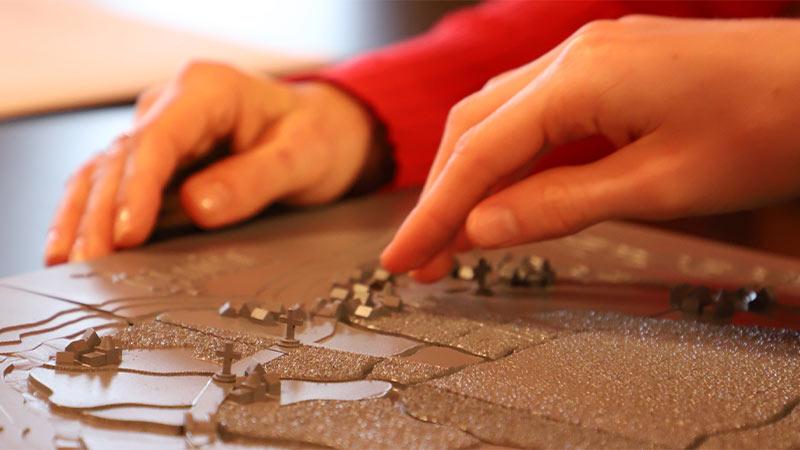A National Archive workshop called Sensing the Archives, for visually impaired students is using resources created by George Rhodes, the Digital Accessibility Team Lead at the University of Westminster. As a result of his PhD research into new tactile map formats, Rhodes has created 3D-printed tactile versions of six archive documents, four of which were shared in the workshop. His project allowed the visual aspects of two-dimensional records to come to life outside visual descriptions.

The workshop was first trialled on 18 March with 11 Key Stage Three and Four pupils from New College Worcester, a school for young people with vision impairments or blindness. They were accompanied by nine Qualified Teachers of the Visually Impaired (QTVIs), working closely with Jeanette Normanton-Erry, the Head of History at the school. The workshop aimed to discuss how to make archives accessible and engaging to visually impaired individuals, where they made use of exploration relying on senses excluding sight, such as touch, sound and smell. It centred around innovative 3D-printed tactile versions of these documents.
The project was led by Ellen Oredsson, Digital Project Officer at The National Archives, and supported by George Rhodes and All Able Ltd, Rhodes’s accessibility consultancy business committed to delivering accessible and inclusive services that work for everyone. The project was featured on Make Things Accessible, a community-led project managed by Rhodes aiming to pool combined efforts and knowledge on delivering accessible experiences for students and Higher Education colleagues. This is a shared effort between several universities across London, with Westminster being one of the main collaborators.
The final four documents that were shared at the workshop were the Peterloo Massacre engraving in 1819, the Inclesmoor map in 1450, the Meeting at Carberry Hill in 1567 and John Blanke’s wage slip in 1507. After students felt the documents, they explored bags with sensory clues, such as material samples, sound buttons, smell pots and a soft toy rat, to discover the context of the documents from the collection. The workshop ended with the students exploring the original documents and two significant documents from the Safe Room, a new permanent gallery allowing visitors to discover the collection through originals, replicas and props. These were The Tide letter written by Elizabeth I and Henry VIII’s will.
To develop the tactile documents, Rhodes used his newly developed method called optacartography, which converts 2D maps and images into high fidelity tactile diagrams. The process begins with an initial graphic being adjusted and converted into a 3D file by identifying areas of the map that the creator wants extruded to different heights. Resin 3D printing was used to reduce printing time and costs in comparison to extrusion printing, another method of 3D printing that builds 3D parts layer by layer using spools of plastic filament that extrudes via a heated nozzle.
George Rhodes is currently studying for his PhD at the University of Kent where he focuses on building easier ways and formalising a lower barrier to entry for people, particularly small-scale creators, to create tactile alternatives using 3D printing. About the workshop, he said: “It was a fantastic opportunity to be involved in something that directly impacted disabled users and their experience of our country’s history. I do a lot of work behind the scenes on accessibility regulations, or making sure websites and digital content are accessible, so it makes a change to get out there and see the impact of my accessibility work on the faces of people interacting with the tactile formats I have made.”
He added: “While this was a project I did in my own time as part of my personal research, we try to embody this proactive and sharing attitude in the work we do at Westminster. We want to share our knowledge and work with others to spread those positive experiences and make sure students, colleagues and everyone else can have an accessible time here.”
A few teachers gave feedback about the workshop and said: “There was a lot of consideration and very individual needs which all went well because we had a very broad range of learners who all got a lot out of the day. Being given the outline of the day beforehand, I was able to sit them down and tell them what was going to happen, which removed all the anxiety. The students coped brilliantly because the environment had been set up in a way that was non-threatening in any shape or form. So, those little things are also so important. The students really enjoyed it. I think that the more you can have tactile materials, the better.”
This workshop directly contributes to the United Nations Sustainable Development Goal (SDG) 10: Reduced Inequalities. Since 2019, the University of Westminster has used the SDGs holistically to frame strategic decisions to help students and colleagues fulfil their potential and contribute to a more sustainable, equitable and healthier society.
Learn about the aid that Westminster’s Disability Learning Support Team offers to students with visual impairments.

Photo Credit: The National Archive

